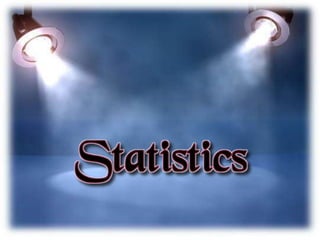
Statistics
- 2. Introduction Statistics is the study of the collection, organization, analysis, interpretation, and presentation of data. It deals with all aspects of this, including the planning of data collection in terms of the design of surveys and experiments.
- 3. History The use of statistical methods dates back at least to the 5th century BC. The earliest writing on statistics was found in a 9th century book entitled: "Manuscript on Deciphering Cryptographic Messages", written by Al-Kindi. In his book, he gave a detailed description of how to use statistics and frequency analysis to decipher encrypted messages, this was the birth of both statistics and cryptanalysis, according to the Saudi engineer Ibrahim Al-Kadi.
- 4. Collection Of Data 1. When information is collected by the investigator herself or himself with a definite objective in mind, is known as PRIMARY DATA. 2. The information was gathered from a source which already had the information stored, the data obtained in this way is known as the SECONDARY DATA.
- 5. Presentation of Data The Type Of Data we collected is known as raw data. We can present it in a number of ways like: 1. Frequency Table 2. Bar Graphs 3. Histogram 4. Frequency polygon 5. Line Graph. 6. Pie chart
- 6. A graph consisting of rectangles whose area is proportional to the frequency of a variable and whose width is equal to the class interval. It was first introduced by Karl Pearson. It is said to be derived from the Greek histos 'anything set upright' (as the masts of a ship) and gramma 'drawing, record, writing'.
- 7. In a Frequency Polygon, a line graph is drawn by joining all the midpoints of the top of the bars of a histogram. A frequency polygon gives the idea about the shape of the data distribution.The two end points of a frequency polygon always lie on the x- axis.
